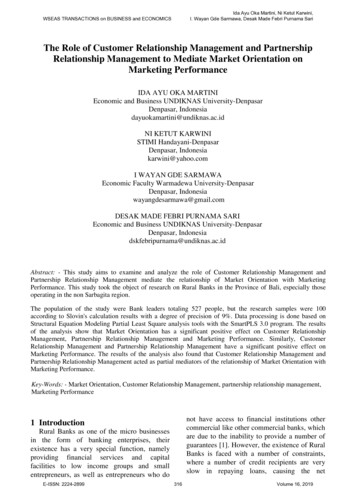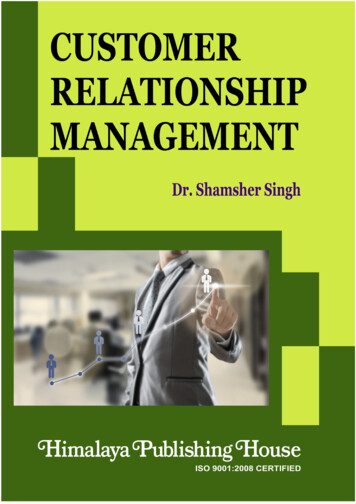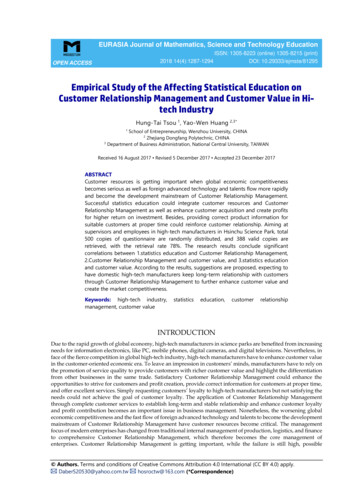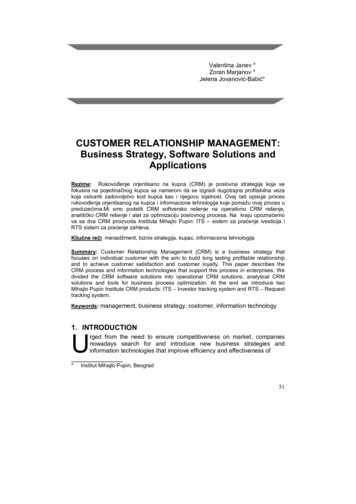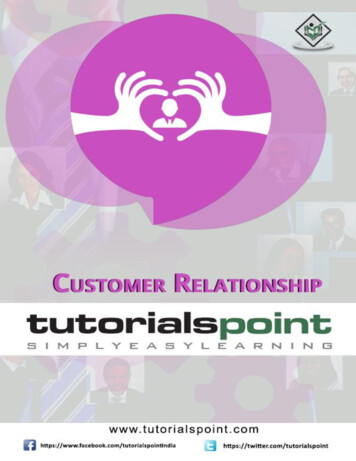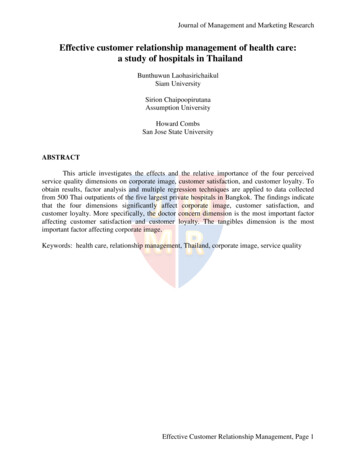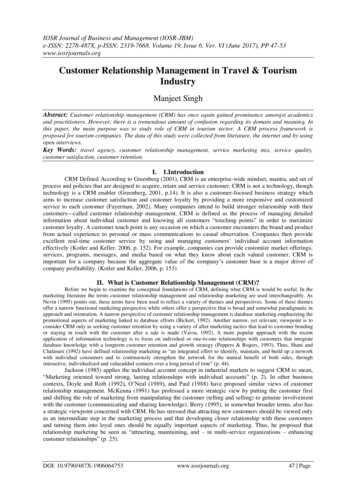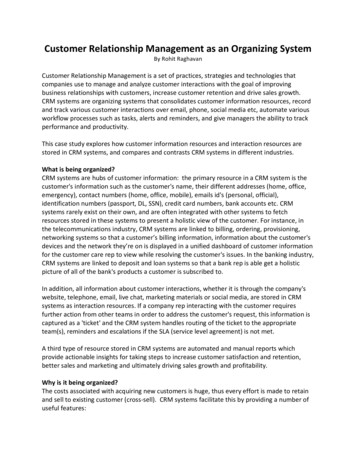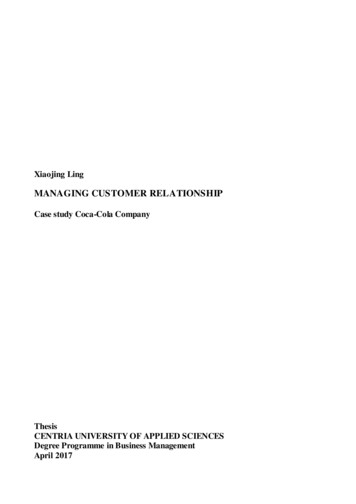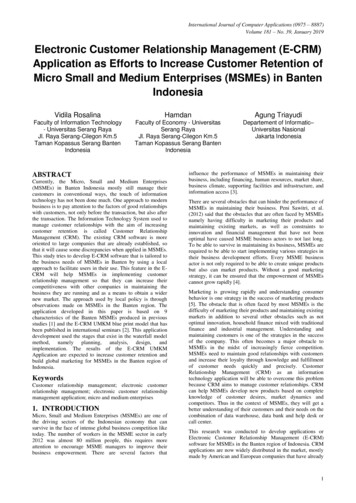
Transcription
International Journal of Computer Applications (0975 – 8887)Volume 181 – No. 39, January 2019Electronic Customer Relationship Management (E-CRM)Application as Efforts to Increase Customer Retention ofMicro Small and Medium Enterprises (MSMEs) in BantenIndonesiaVidila RosalinaHamdanAgung TriayudiFaculty of Information Technology- Universitas Serang RayaJl. Raya Serang-Cilegon Km.5Taman Kopassus Serang BantenIndonesiaFaculty of Economy - UniversitasSerang RayaJl. Raya Serang-Cilegon Km.5Taman Kopassus Serang BantenIndonesiaDepartement of Informatic–Universitas NasionalJakarta IndonesiaABSTRACTCurrently, the Micro, Small and Medium Enterprises(MSMEs) in Banten Indonesia mostly still manage theircustomers in conventional ways, the touch of informationtechnology has not been done much. One approach to modernbusiness is to pay attention to the factors of good relationshipswith customers, not only before the transaction, but also afterthe transaction. The Information Technology System used tomanage customer relationships with the aim of increasingcustomer retention is called Customer RelationshipManagement (CRM). The existing CRM software is moreoriented to large companies that are already established, sothat it will cause some discrepancies when applied in MSMEs.This study tries to develop E-CRM software that is tailored tothe business needs of MSMEs in Banten by using a localapproach to facilitate users in their use. This feature in the ECRM will help MSMEs in implementing customerrelationship management so that they can increase theircompetitiveness with other companies in maintaining thebusiness they are running and as a means to obtain a widernew market. The approach used by local policy is throughobservations made on MSMEs in the Banten region. Theapplication developed in this paper is based on 9characteristics of the Banten MSMEs produced in previousstudies [1] and the E-CRM UMKM blue print model that hasbeen published in international seminars [2]. This applicationdevelopment used the stages that exist in the waterfall modelmethod, namely planning, analysis, design, andimplementation. The results of the E-CRM UMKMApplication are expected to increase customer retention andbuild global marketing for MSMEs in the Banten region ofIndonesia.KeywordsCustomer relationship management; electronic customerrelationship management; electronic customer relationshipmanagement application; micro and medium enterprises1. INTRODUCTIONMicro, Small and Medium Enterprises (MSMEs) are one ofthe driving sectors of the Indonesian economy that cansurvive in the face of intense global business competition liketoday. The number of workers in the MSME sector in early2012 was almost 80 million people, this requires moreattention to encourage MSME managers to improve theirbusiness empowerment. There are several factors thatinfluence the performance of MSMEs in maintaining theirbusiness, including financing, human resources, market share,business climate, supporting facilities and infrastructure, andinformation access [3].There are several obstacles that can hinder the performance ofMSMEs in maintaining their business. Peni Sawitri, et al.(2012) said that the obstacles that are often faced by MSMEsnamely having difficulty in marketing their products andmaintaining existing markets, as well as constraints toinnovation and financial management that have not beenoptimal have caused MSME business actors to not last long.To be able to survive in maintaining its business, MSMEs arerequired to be able to start implementing various strategies intheir business development efforts. Every MSME businessactor is not only required to be able to create unique productsbut also can market products. Without a good marketingstrategy, it can be ensured that the empowerment of MSMEscannot grow rapidly [4].Marketing is growing rapidly and understanding consumerbehavior is one strategy in the success of marketing products[5]. The obstacle that is often faced by most MSMEs is thedifficulty of marketing their products and maintaining existingmarkets in addition to several other obstacles such as notoptimal innovation, household finance mixed with traditionalfinance and industrial management. Understanding andmaintaining customers is one of the strategies in the successof the company. This often becomes a major obstacle toMSMEs in the midst of increasingly fierce competition.MSMEs need to maintain good relationships with customersand increase their loyalty through knowledge and fulfillmentof customer needs quickly and precisely. CustomerRelationship Management (CRM) as an informationtechnology application will be able to overcome this problembecause CRM aims to manage customer relationships. CRMcan help MSMEs develop new products based on completeknowledge of customer desires, market dynamics andcompetitors. Thus in the context of MSMEs, they will get abetter understanding of their customers and their needs on thecombination of data warehouse, data bank and help desk orcall center.This research was conducted to develop applications orElectronic Customer Relationship Management (E-CRM)software for MSMEs in the Banten region of Indonesia. CRMapplications are now widely distributed in the market, mostlymade by American and European companies that have already1
International Journal of Computer Applications (0975 – 8887)Volume 181 – No. 39, January 2019implemented CRM in their companies. AMR Research reportsseveral CRM software providers such as Siebel Systems,Microsoft, Clarify (Nortel Networks), PeopleSoft and Oracleas market leaders. Meanwhile, CRM professional servicecompanies which are market leaders such as Accenture, ArtTechnology Group, Cambridge Technology Partners, CSC,Deloitte Consulting, EDS, eLoyalty, Cap Gemini Ernst &Young, IBM Global Services, KPMG Consulting and PriceWaterhouse Coopers. This shows that CRM softwareproviders are mostly foreign companies that might makeMSMEs reluctant to use CRM applications into their businessventures, because of the high cost of the application andforeign vendors still lack understanding of unique small andmedium business process preparation [6] [11] [12] [13]. Thisresearch is motivated by the fact that there are currently noMSMEs in the Banten province of Indonesia that haveimplemented E-CRM, although many MSMEs have realizedthe importance of E-CRM and the use of information systemsis a necessity that cannot be avoided by any business theforemost position in an industry. The following are MSMEsdata in the Banten province (Table 1)Table 1: MSME Data Based on Business Units in Banten ProvinceBusiness CategoryMicroSmallMediumTotalMining and excavation2.463235192.717Processing industry79.9289.19278790.907Electricity, gas and water1653286283Construction3.7816412214.643Retail and trade330.95993.8522.685427.496Accommodation and provision offood and drink127.78824.585452150.825Transportation, warehousing andcommunication161.0698.134431169.634Financial intermediary5965984621.656Real estate, rental business46.1785.19257251.942Educational services8.4652.39228111.138Health services and socialactivities5.1971.3831586.738Community, social culture,entertainment and otherindividuals services49.9126.99514357.050Individual services that 309984.118(Source: dinkopukm.bantenprov.go.id)Meanwhile, based on a survey conducted in 2017 the level ofutilization of CRM / E-CRM in MSMEs in Banten provinceturned out that from sample data of 30 respondents wereknown 100% of MSME actors had not utilized andimplemented CRM and E-CRM in managing relationshipswith customers (Figure 1) [7].2
International Journal of Computer Applications (0975 – 8887)Volume 181 – No. 39, January 2019oftenevernumber ofrespondentssometimesnever010203040Figure: 1 Utilization Level of CRM/E-CRM in MSMESThis is what motivates this research to be conducted to helpMSMEs in their business by designing E-CRM applicationthat is easy and affordable. Thus the formulation of theproblem in this study is "How is the software development orElectronic Customer Relationship Management (E-CRM)application in Micro, Small and Medium Enterprises(MSMEs) in Banten province based on the characteristics ofthe Banten MSMEs using the waterfall method?". The resultsof the development of the E-CRM UMKM are expected tocontribute to development activities in terms of computationaltechniques. The purpose of this study was to implementtechnology, especially in the field of ICT to support economicimprovement in the Banten region of Indonesia. The featuresin this E-CRM will help MSMEs in implementing customerrelationship management so that they can increase theircompetitiveness with other companies in maintaining thebusiness they are running and as a means to obtain a widernew market. The development of the E-CRM UMKMapplication device is through the stages that exist in thewaterfall model software development method discovered byWinston W. Royce in 1970, namely planning, analysis,design, and implementation [8]. The results of the E-CRMUMKM application developed in this study are expected to beable to increase customer retention and build global scalemarketing in MSMEs in the Banten region of Indonesia.2. RESEARCH METHODThe following are the steps that have been carried out in theoverall research on the development of E-CRM UMKM inBanten province of Indonesia, namely: (1) Observation andData Collection of MSMEs in Banten Province, (2)Requirement Analysis of E-CRM UMKM in Banten , (3)Requirements for identification systems using the 6 ZachmanFramework perspective, namely scope, business model,system model, technology model, component, and workingsystem [14], (4) Produced 10 Characteristics of E-CRMModeling with Local Wisdom to MSMEs in Banten Province[1] [10], (5) E-CRM UMKM Modeling uses 4 ZachmanFramework matrices namely why, how, what, who, (6) CRMModeling with Unified Model Language (UML) Diagram AsEfforts to Increase Retention Customers of MSMEs in BantenProvince, (7) Software development based on 9 characteristicsof the E-CRM UMKM in Banten by using the WaterfallModel method through the stages: Planning, Analysis, Design,and Implementation, (8) So that E-CRM UMKM ApplicationAs Efforts to Increase Customer Retention of MSMEs inBanten Indonesia.3
International Journal of Computer Applications (0975 – 8887)Volume 181 – No. 39, January 2019Observation and Data Collection of MSMEs in Banten ProvinceRequirement Analysis of E-CRM UMKM systemRequirements identification system using the Zachman FrameworkBusinessModelScopeSystem ristics of E-CRM Modeling with Local Wisdom to MSMEs in Banten ProvinceWhyHowWhatWho-CRM Modeling with UML Diagram As Efforts to Increase Retention Customers of MSMEs inBanten IndonesiaPengembangan perangkat lunak berdasarkan 9 karakteristik E-CRM UMKM di Bantenmenggunakan metode Waterfall Model (Planning, Analysis, Design, and Implementation)E-CRM MSMEs Application As Efforts to Increase Customer Retention s of MSMEs in BantenIndonesiaFigure 2: Process and Stage of E-CRM Implementation for MSMEs in Bantenthe E-CRM characteristics of MSMEs in the Banten region donot require features such as those in large companies butBased on the results of observations and needs analysis thatsimple features tailored to the needs of MSMEs and loadedhas been described in the previous stages, namely,with local languages to present a userfriendly impression toidentification of E-CRM needs for MSMEs in the BantenMSME actors. The following are 9 characteristics [1] thatregion by using the Zachman Framework which includes sixmust be applied to the E-CRM UMKM application in Bantenperspectives (scope, business model, system model,province:technology model, component, and working system ) canproduce a fairly complete and comprehensive analysis so thatTable 2. Characteristic of E-CRM UMKM and Its Implementation in Banten Province3. ANALYSIS AND RESULTNoCharacteristicImplementation in Application1Local languageUsing what MSME actors and customers use, namely, Indonesian2Economical investmentThe investation is only smartphone3Easy to use and installCan be downloaded quickly through Google Play and can be usedimmediately and easily4Minimalis featureThe features used by MSMEs are generally very minimalist, namely:product management and customer management5User friendly interfaceIt is very easy to use as evidenced by the results of a limited pretestand post test in using E-CRM UMKM application that has been carriedout for MSME actors, which is 98% can immediately understand theuse of E-CRM UMKM applications. [9]6Android base interfaceCan be used on all versions of the Android operating system4
International Journal of Computer Applications (0975 – 8887)Volume 181 – No. 39, January 20197Online or offline run applicationFor some customer relationship management features can be usedoffline for example: customer data, customer testimonial data,customer complaint data, customer satisfaction data8Simple databaseThe database is relatively simple with a simple class diagramconsisting of 20 classes9Use open source softwareAll of them use open source software to avoid dependency and costsThe following are the stages of developing E-CRM UMKMsoftware in Banten province using the waterfall model and theresults of each of these stages:Planning E-CRM UMKMProject PlannerAnalysis 10 Characteristics that an E-CRMUMKM must haveDesign UML Diagram of E-CRM UMKM Implementation of 10 Characteristicsof E-CRM UMKMImplementation E-CRM UMKMapplicationFigure 3. Development Stages of E-CRM UMKMThe following is the appearance of the E-CRM UMKMapplication developed using the waterfall method and built onnine characteristics of MSMEs inBanten and the UML model resulting from the translation offour Zachman framework matrices:Figure 4: Dashboard of E-CRM UMKM with a touch of local wisdom in the form of the Banten Mosque Tower Sketch5
International Journal of Computer Applications (0975 – 8887)Volume 181 – No. 39, January 2019Figure 5: Searching Product Feature using Indonesian LanguageFigure 6: Searching Product based on Category with User Friendly6
International Journal of Computer Applications (0975 – 8887)Volume 181 – No. 39, January 2019Figure 7: Login E-CRM UMKMFigure 8: Minimalist features of E-CRM UMKM4. CONCLUSIONFrom the discussion of the process, analysis and resultsdescribed above, the following conclusions can be drawn:a.Development of E-CRM software for MSMEs inthe Banten region by referring to the 9characteristics of the Banten MSMEs, namely,Indonesian language, economic investment, easy touse and install, minimalist features, user friendlyinterface, android base interface, online and offlinerun application, simple database, use open sourcesoftware produces the MSMEs E-CRM applicationthat presents a simple impression and has localwisdom, user friendly and easy to use by MSMEsactors in Banten in managing relationships withcustomers so the goal of building global marketingand increasing retention of MSME customers can beachieved.7
International Journal of Computer Applications (0975 – 8887)Volume 181 – No. 39, January 2019b.The development of E-CRM application in MSMEsin the Banten region through the stages of thewaterfall model, namely planning, analysis, design,and implementation is quite effective and efficientso that it produces E-CRM UMKM in Bantenprovince Indonesia.5. ACKNOWLEDGEMENTThe authors would like to thank the Ministry of ResearchTechnology and Higher Education of the Republic ofIndonesia (KEMENRISTEKDIKTI) for the financial support.6. REFERENCES[1] Rosalina, Vidila., dkk. 2017, Electronic CustomerRelationship Management (E-CRM) Modeling on Micro,Small & Medium Enterprises (MSMEs) Banten,International Journal of Computer Applications (0975 –8887) Volume 176, October 2017, New York, USA.[2] Rosalina, Vidila, dkk. 2018, , Electronic CustomerRelationship Management (E-CRM) Modeling As Effortto Increase Customer retentionon Micro, Small &Medium Enterprises (MSMEs) Banten. ICComSET 2627 November 2018, Universitas Tasikmalaya, JawaBarat, Indonesia[3] Rifa'i, B. 2013. Efektivitas Pemberdayaan Micro Smalland Medium Enterprises (UMKM) Krupuk Ikan kat Desa Kedung Rejo Kecamatan JabonKabupaten Sidoarjo. Kebijakan dan Manajemen Publik,130-136[4] Sawitri,P., Wulandari, L., Simri, L.I.W. 2012. CRMuntuk UKM, Konferensi Nasional Sistem Informasi2012, STMIK - STIKOM Bali 23-25 Pebruari 2012[5] Rosalina, Vidila. 2013, Pemodelan CRM k, Jurnal ELECTRANS ISSN 1412-3762,Volume 12 No 2 September 2013, UPI, Bandung.[7] Rosalina, Vidila, dkk. 2017. Sosialisasi Pemanfaatan ECRM untuk Meningkatkan Retensi Pelanggan UMKM .Jurnal Wikrama Parahita Vol 1 No1. November 2017[8] Pressman, RogerCycle/WaterfallS. 1997. Metode The Classic Life[9] Rosalina Vidila. 2018. Pemanfaatan Aplikasi E-CRMDalam Upaya Meningkatkan retensi Pelanggan UMKM,Seminar Nasional SEMBADHA 2018 pada tanggal 1718 November 2018. Di Sekolah Tinggi AkuntansiNegara (STAN) Bintaro Banten.[10] Rosalina, Vidila, dkk. 2017. Model Electronic CustomerRelationship Management (E-CRM) MenggunakanAdaptasi Bahasa Lokal Pada Usaha Mikro KecilMenengah (UMKM) Banten, Prosiding SENASSET2017 (Seminar Nasional Riset Terapan) ISBN 978-60273672-0-3 : 12, November 2017.[11] Hashim, R. 2012. Adoption of enterprise informationsystem (EIS) in Malaysian small and medium enterprises(SMEs). Business, Engineering and IndustrialApplications (ISBEIA), 2012 IEEE Symposium: 425 430.[12] Garcia, I., Pacheco, C., Martinez, A. 2012. IdentifyingCritical Success Factors for Adopting CRM in Small: AFramework for Small and Medium Enterprises. SoftwareEngineering Research, Management and Applications2012, Studies in Computational Intelligence Volume430, 2012, pp 1-15[13] Nugraha, A., Dewi, I.N., Novianto, S. 2013. onship Management dalam Mendukung StrategiPemasaran dan Pengelolaan Pelanggan UMKM,Konferensi Nasional Informatika (KNIF) ITB 2013.[14] Zachman, J.A., 2012, John Zachman's ww.zachman.com/aboutthe-zachman-framework.[6] Danardatu, Aloysius Heru. 2003, Pengenalan CustomerRelationship Management, Ilmu Komputer.ComIJCATM : www.ijcaonline.org8
Customer relationship management; electronic customer relationship management; electronic customer relationship management application; micro and medium enterprises 1. INTRODUCTION Micro, Small and Medium Enterprises (MSMEs) are one of . Microsoft, Clarify (Nortel Networks), PeopleSoft and Oracle as market leaders. Meanwhile, CRM professional .
